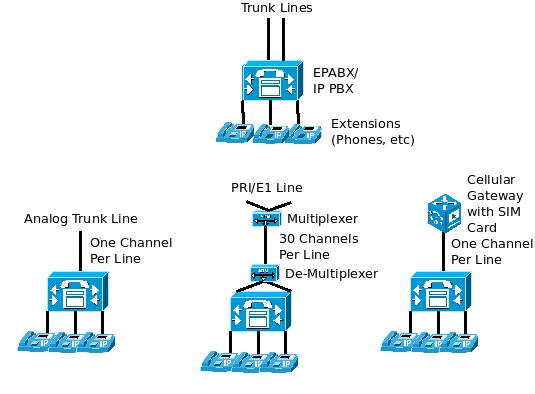Why do you need a PBX?
we need to understand some background about what is a PBX and why we need it. PBX actually refers to Private Branch Exchange. Imagine this situation – You have 100 employees in your organization, and all of them work from their office. Each one of them need to make outgoing calls (to partners, customers, etc) and also need to talk to their colleagues.
If there was no PBX, you have to procure 100 different analog trunk lines (from a Telecom service provider) to give telephone access to all of them. They can call each other, but those calls will also be charged as they are routed from the public telephone exchange. So, obviously this method is inefficient.
So, a small private branch exchange – PBX (Telecom switch) is kept at the organization to achieve two important purposes :
1. To share the incoming (trunk) lines from public telephone exchange to all employees as every employee is not going to be making outgoing calls/ receiving incoming calls all the time. So, instead of buying a trunk line for every employee, you might just buy one line for ten employees (sufficient in most cases) and share them.
2. To make internal calls (based on extension numbers) without any charge. Since the PBX is a mini-switch, it can route calls from one extension to another extension internally.
Analog Trunk Lines:
The phone line (land-line) that you get in your home is an example for an analog trunk line. At homes, one line would suffice. But in organizations, multiple such lines might be required (as the number of telephone users are more). These analog trunk lines carry a single channel of voice call per line (meaning, one person can make or receive a phone call from outside at any given point of time).
For terminating the analog trunk lines in a PBX, special analog trunk cards (12 ports, 24 ports, etc) are used. In an IP PBX, Analog Terminal Adapters (ATA) or PCI based Analog Cards may be used. These devices convert the analog calls into IP so that an IP PBX can understand them and transmit them over the network.
Separate rental / call charges needs to be paid for each analog trunk. Analog trunk lines are sufficient for small organizations which require a few lines.
PRI / E1 / T1 Lines:
For larger organizations that require a lot of trunk lines, procuring additional analog trunks might not be a practical idea as they need to buy separate (perhaps multiple) analog trunk cards to terminate these lines in their PBX (and) they need to pay separate rental for each line where the free call capacity for some individual lines might never be reached!
So, these organizations can procure a digital line called as PRI/ E1 (In Europe/ Asia) or T1 (In America). Each PRI / E1 line can carry up to 30 channels of voice communications simultaneously. They can do this by using multiplexing/ de-multiplexing techniques (at the public telephone exchange end -and- the customer PBX end). A T1 line, similarly can carry up to 24 channels of voice communications simultaneously.
At the customer end, they need to procure a PRI / E1/ T1 Card, to terminate this PRI/ E1/ T1 line in their PBX. Just imagine – One line coming into your organization but thirty people can simultaneously make or receive calls through it! And add to it a single consolidated rental / billing package from the Telecom company. You can read more about PRI lines and its advantages from here.
There is another type of digital line called ISDN line. With ISDN, two simultaneous calls can be made/ received at the same time using a single line.
GSM/ Cellular Gateway:
In some situations, it may not be feasible to lay analog lines (over a hill, rural areas, etc). But those places might be covered by cellular companies/ signal from cell phone towers. In such situations, you can use a GSM / CDMA Cellular gateway device called as Fixed Cellular Terminal and use the Cell phone SIM cards as analog trunks for your PBX. These devices are in fact connected to the analog trunk ports of the PBX.
A Fixed Cellular Terminal is a small device in which you can insert a SIM card and connect the single-pair copper telephone cable coming out of it, directly to a telephone (or) to a PBX. At the other end of the PBX, the extensions (normal phones) are connected. So, when someone makes an outgoing call, the request reaches the PBX and the call is directed to the Cellular Gateway which has the SIM card. Some cellular gateways have multiple SIM cards, enable multiple simultaneous calls to/from outside.
So, even though people might dial a number from their land line extension, the call actually goes through the cellular network using the GSM/ CDMA Cellular Gateway.
VOIP / SIP Trunks:
Of late, VOIP service providers have become very popular. They use the Internet backbone (mostly) to transmit the call as IP packets to the destination. They have gateways (where required) to convert the IP calls to analog calls before passing them on to the local telephone exchanges so that people can reach normal landline/ cell phone numbers using the VOIP Service. You can read more about SIP Trunks from here.
excitingIP.com
You could stay up to date on various computer networking/ related IT technologies by subscribing to this blog with your email address in the sidebar box that says, 'Get email updates when new articles are published'
You received this message because you are subscribed to the Google Groups "Keep_Mailing" group.
To unsubscribe from this group and stop receiving emails from it, send an email to keep_mailing+unsubscribe@googlegroups.com.
To post to this group, send email to keep_mailing@googlegroups.com.
Visit this group at https://groups.google.com/group/keep_mailing.
To view this discussion on the web visit https://groups.google.com/d/msgid/keep_mailing/CAG%3DbiTvZuJPk2YYaE89%3DYByWv2G_fP64MAUQYNY%2B8apos45Cmg%40mail.gmail.com.
For more options, visit https://groups.google.com/d/optout.

No comments:
Post a Comment